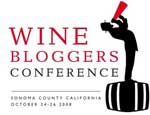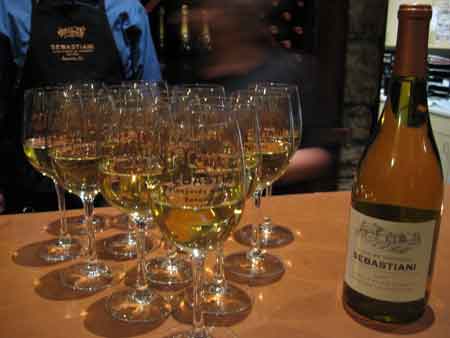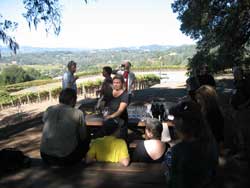Five Things I Learned at the Wine Bloggers Conference
 By now, many other wine bloggers have given their comments on the Wine Bloggers Conference. There have been reviews on the top new wines, 3 to 12 part reflections and even a dollop of paranoia. My “lessons learned” comments on the WBC in this column focus on what blogging potentially holds to expand the voice of Texas wine drinkers.
By now, many other wine bloggers have given their comments on the Wine Bloggers Conference. There have been reviews on the top new wines, 3 to 12 part reflections and even a dollop of paranoia. My “lessons learned” comments on the WBC in this column focus on what blogging potentially holds to expand the voice of Texas wine drinkers.

1. The Texas Niche– As I mentioned in my previous blog, Texas is a niche in the wine world. Consumers looking for tips on Texas wines are more likely to get information from local sources. These can be local foodie magazines and newspapers and increasingly bloggers that are giving more “face-time” to Texas wines.
2. Blogs Bring New Insights:Bloggers come from all points of view. Some are involved in sales and marketing, others focus on evaluation, some are serious writers and others are hobbyists. They potentially provides a broader range of viewpoints than often make it into the print media. Texas wines have suffered more from a lack of news coverage and evaluation than from bad reports. Blogs hold the potential to bring new more in depth knowledge of the local wine scene as many Texas bloggers have actually walked in Texas vineyards, visited our wineries and tasted a range of Texas wines.
3. Know Your Blogger – Often the barrier to getting information on Texas wines distributed is that people in the industry have a vested interest to sell the wines they currently sell. The last thing they want is another brand, particularly if it is not getting national media coverage. But, information gained by reading blogs is no different than any information obtained on the Internet. In addition to asking yourself…. What is the blogger saying? Three additional questions need to be asked – Why is the information being conveyed? Does the information come from a credible source? Does the blogger stand to financially benefit or be negatively affected from the exchange of information?
4. Blogging as an Exchange of Ideas – Blogging should be a “three-way” street. Do not just read blogs, participate in them. Challenge the blogger and other readers. If word gets out that consumers are asking questions and looking for Texas wines, the market will find a way to provide them. This is particularly true to retail establishments like wine shops and restaurants. Many wine industry representatives are starting to read blogs to get recon on rapidly changing consumer tastes and trends and to get a “leg-up” on their competition.
5. Blogging Democracy– This is a corollary to Item 4 above. Use blogs to pose unsolicited questions to bloggers. You can help guide bloggers to disseminate information to your computer that you really want. I started a question on Texas wine on the California-base, Open Wine Consortium blog. I was surprised how quickly the topic elicited readership and responses. Some people still did not know that Texas was the fifth largest wine producing state or that Texas wines have garnered national and international awards. Others had traveled through Texas on business or pleasure and had a good report on certain Texas wines.
All in all, the WBC was an eye-opening experience. I believe that my report on my “accidental” wine blogging experience and niche identification to others at the conference helped them see their own blog in a different light. It is often easier to simply make your blog a clone of the mainstream media publications. But, wine blogs offer so much more if you can find just the right niche. They bring a new way to establish community between kindred spirits of the wine world.
In addition to these lessons, I was also exposed to the new technologies for social networking, blog monetization, and the importance of credibility. In the coming months, I hope to implement several of these new aspects into VintageTexas.com to better communicate with my readership and provide a sustainable forum on Texas wines.
 I can not leave this topic without acknowledging the joy of the real-world aspect of face-to-face interactions between people that I have only met virtually through the online graphic interface of their blog.
I can not leave this topic without acknowledging the joy of the real-world aspect of face-to-face interactions between people that I have only met virtually through the online graphic interface of their blog.
Additionally, the setting of Sonoma County was wonderful. We were able to get physical and tactile experiences of terroir by walking in the vineyard and talking to vineyard and winery personnel that spend days and nights getting the most they can out of the ground and into the glass. Then, we also had the ultimate experience of tasting the product of the same vineyard.

Hi — nice article. We were at the WBC and blog about Texas wines, too. It’s nice to help push along the industry a bit on the web.
Neil wrote an article about the WBC that focuses on issues similar to those you raised in some of your points on blogging. Check it out:
http://wineenabler.com/sensing-revolution-at-the-wine-bloggers-conference/
Wine info of the people, by the people and for the people, shall not perish from this earth….democracy now!
Russ Kane
I just got an email from someone that thinks that I should have included another important point. Blogging for Education…..
People will seek information and sometimes ask questions online, even when they will not ask questions in person. They are afraid that they may look stupid in front of others.
Russ
Excellent wine blogging article. Great looking site.
I have added your blog to the blogroll on my Oklahoma Wine News blog.
Congrats on your blog! Some good stuff here!
I appreciate your comment.
I visited your blog on American Terrior and the high acidity Texas wine run through RO.
I likely know which one it is from your description. Some people get crazy for that stuff.
Russ